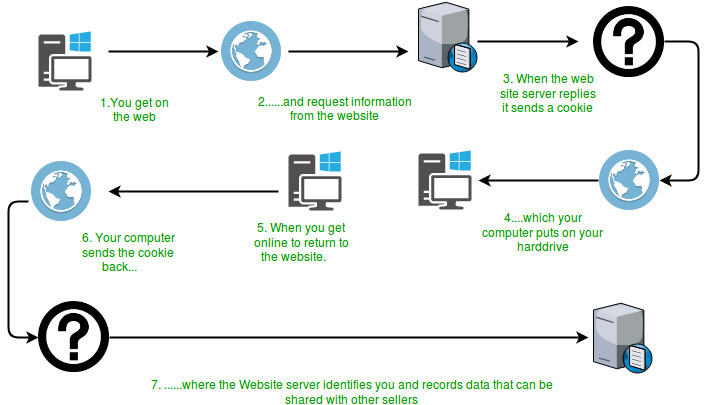許多網站使用稱為 cookie 的小文本字符串來存儲連接之間的持久客戶端狀態。 Cookie 在請求和響應的 HTTP 標頭中從服務器傳遞到客戶端,然後再次傳遞返回。服務器可以使用 Cookie 來指示會話 ID、購物車內容、登錄憑據、用戶首選項等。
How Cookies work?
從上圖可以看出,當用戶第一次請求頁麵時,服務器與資源一起發送一個 cookie 對象以存儲在客戶端的計算機上。該對象可能包含請求的詳細信息。現在,如果用戶再次請求相同的資源,它會隨請求一起發送存儲的 cookie,服務器可以使用該 cookie 來進一步增強用戶的體驗。
Cookie 的屬性:
- 名稱=值對:這說明了 cookie 中存儲的實際信息。名稱和值均不應包含空格或以下任何字符:[ ] ( ) = , ” /? @:;
有效 cookie name-value 對的示例:
Set-Cookie:session-id = 187-4969589-3049309
- Domain:默認情況下,cookie 適用於它來自的服務器。如果 cookie 最初是由 www.foo.example.com 設置的,則瀏覽器隻會將該 cookie 發送回 www.foo.example.com。但是,站點還可以指示 cookie 適用於整個子域,而不僅僅是原始服務器。例如,此請求為整個 foo.example.com 域設置用戶 cookie:
瀏覽器不僅會將此 cookie 回顯給 www.foo.example.com,還會回顯給 lothar.foo.example.com、eliza.foo.example.com、enoch.foo.example.com 以及任何其他主機。在foo.example.com 域中。但是,服務器隻能為其直接所屬的域設置 cookie。 www.foo.example.com 無法為 www.geeksforgeeks.org、example.com 或 .com 設置 cookie,無論它如何設置域。Set-Cookie: user = geek ;Domain =.foo.example.com
- Path:當從同一服務器請求子樹中的文檔時,客戶端會回顯該 cookie。但是,它不使用站點上其他目錄中的 cookie。
Set-Cookie: user = geek; Path =/ restricted
- Expires :該日期過後,瀏覽器應從緩存中刪除 cookie。
Set-Cookie: user = geek; expires = Wed, 21-Feb-2017 15:23:00 IST
- Max-Age:此屬性將 cookie 設置為在經過一定秒數後而不是在特定時刻過期。例如,此 cookie 在首次設置後一小時(3,600 秒)過期。
Set-Cookie: user = "geek"; Max-Age = 3600
構造函數:使用指定的name-value對創建一個cookie。
Syntax : public Cookie(String name, String value) Parameters : name : name of the cookie value : value associated with this cookie
方法:
- setDomain():設置此 cookie 可見的域。前麵在cookie部分的屬性中詳細解釋了域。
Syntax : public void setDomain(String pattern) Parameters : pattern : string representing the domain in which this cookie is visible.
- getDomain():返回此 cookie 可見的域。
Syntax : public String getDomain()
- setComment():指定此 cookie 的用途。
Syntax : public void setComment(String purpose) Parameters : purpose : string representing the purpose of this cookie.
- getComment():返回表示此 cookie 用途的字符串。
Syntax : public String getComment()
- setMaxAge():指定此 cookie 過期之前經過的時間(以秒為單位)。
Syntax : public void setMaxAge(long time) Parameters : time : time in seconds before this cookie expires
- getMaxAge():返回此 cookie 的最大年齡部分。
Syntax : public String getMaxAge()
- setPath():指定客戶端應將 cookie 返回到的 cookie 路徑。
Syntax : public void setPath(String path) Parameters : path : path where this cookie is returned
- getPath():返回此 cookie 的路徑部分。
Syntax : public String getMaxAge()
- setSecure():指示發送此 cookie 時是否使用安全協議。默認值為 false。
Syntax : public void setSecure(boolean secure) 參數: secure - If true, the cookie can only be sent over a secure protocol like https. If false, it can be sent over any protocol.
- getSecure():如果此 cookie 必須是,則返回 true
由安全協議發送,否則為 false。Syntax : public boolean getSecure()
- getName():返回 cookie 的名稱。
Syntax : public String getName()
- setValue():初始化後為 cookie 分配新值。
Syntax : public void setValue(String newValue) Parameters : newValue - a String specifying the new value
- getValue :返回 cookie 的值。
Syntax : public String getValue()
- getVersion():如果 cookie 符合原始 Netscape 規範,則返回 0; 1 如果 cookie 符合 RFC 2965/2109
Syntax : public int getVersion()
- setVersion():用於設置此 cookie 使用的 cookie 協議的版本。
Syntax :public void setVersion(int v) Parameters : v - 0 for original Netscape specification; 1 for RFC 2965/2109
- clone():返回此 cookie 的副本。
Syntax : public Cookie clone()
下麵是一個簡單 servlet 程序的 Java 實現,當用戶第一次請求它時,它會在瀏覽器中存儲一個 cookie,然後對於進一步的請求,它會顯示存儲的 cookie。
// Java program to illustrate methods
// of Cookie class
import java.io.IOException;
import java.io.PrintWriter;
import java.util.List;
import javax.servlet.ServletException;
import javax.servlet.annotation.WebServlet;
import javax.servlet.http.Cookie;
import javax.servlet.http.HttpServlet;
import javax.servlet.http.HttpServletRequest;
import javax.servlet.http.HttpServletResponse;
/**
* Servlet implementation class cookieTest
*/
@WebServlet("/cookieTest")
public class cookieTest extends HttpServlet
{
private static final long serialVersionUID = 1L;
/**
* @see HttpServlet#HttpServlet()
*/
public cookieTest() {
super();
// TODO Auto-generated constructor stub
}
/**
* @see HttpServlet#doGet(HttpServletRequest request, HttpServletResponse
* response)
*/
protected void doGet(HttpServletRequest request, HttpServletResponse response)
throws ServletException, IOException
{
response.setContentType("text/html");
// Create a new cookie with the name test cookie
// and value 123
Cookie cookie = new Cookie("test_cookie", "123");
// setComment() method
cookie.setComment("Just for testing");
// setDomain() method
// cookie.setDomain("domain");
// setMaxAge() method
cookie.setMaxAge(3600);
// setPath() method
cookie.setPath("/articles");
// setSecure() method
cookie.setSecure(false);
// setValue() method
cookie.setValue("321");
// setVersion() method
cookie.setVersion(0);
response.addCookie(cookie);
PrintWriter pw = response.getWriter();
pw.print("<html><head></head><body>");
Cookie ck[] = request.getCookies();
if (ck == null) {
pw.print("<p>This is first time the page is requested.</p>");
pw.print("<p>And therefore no cookies found</p></body></html>");
} else {
pw.print("<p>Welcome Again...Cookies found</p>");
for (int i = 0; i < ck.length; i++) {
// getName() method
pw.print("<p>Name :" + ck[i].getName() + "</p>");
// getValue() method
pw.print("<p>Value :" + ck[i].getValue() + "</p>");
// getDomain() method
pw.print("<p>Domain :" + ck[i].getDomain() + "</p>");
// getPath() method
pw.print("<p>Name :" + ck[i].getPath() + "</p>");
// getMaxAge() method
pw.print("<p>Max Age :" + ck[i].getMaxAge() + "</p>");
// getComment() method
pw.print("<p>Comment :" + ck[i].getComment() + "</p>");
// getSecure() method
pw.print("<p>Name :" + ck[i].getSecure() + "</p>");
// getVersion() method
pw.print("<p>Version :" + ck[i].getVersion() + "</p>");
}
pw.print("<body></html>");
}
pw.close();
}
/**
* @see HttpServlet#doPost(HttpServletRequest request, HttpServletResponse
* response)
*/
protected void doPost(HttpServletRequest request, HttpServletResponse response)
throws ServletException, IOException
{
doGet(request, response);
}
} 輸出:以下輸出來自網絡瀏覽器 -
對於第一個請求:
This is first time the page is requested. And therefore no cookies found.
對於第二個請求:
Welcome Again...Cookies found Name :test_cookie Value :321 Domain :null Name :null Max Age :-1 Comment :null Name :false Version :0
How to run the above program?
首先,確保您安裝了 Apache Tomcat 等服務器,並使用您正在使用的工具(如 Eclipse)進行了配置。隻需在服務器或本地瀏覽器上運行上述程序,隻需輸入您正在使用的服務器目錄的完整地址即可。
CookieTest servlet,一個執行三項任務的 servlet:
- 首先,servlet 設置一個名為 test_cookie 的 cookie。程序中的其他行設置cookie的屬性,例如最大年齡、域、值等。
- 其次,servlet 使用request.getCookies 查找所有傳入的 cookie 並顯示它們的名稱和其他相應屬性。
- 如果像第一次請求一樣沒有找到 cookie,則會顯示一條簡單的顯示消息,告訴您這是第一次訪問該頁麵。
參考:Official Java Documentation
相關用法
- Java Java.io.BufferedInputStream.available()用法及代碼示例
- Java Java.io.BufferedInputStream.close()用法及代碼示例
- Java Java.io.BufferedInputStream.read()用法及代碼示例
- Java Java.io.BufferedInputStream.reset()用法及代碼示例
- Java Java.io.BufferedInputStream.skip()用法及代碼示例
- Java Java.io.BufferedOutputStream.flush()用法及代碼示例
- Java Java.io.BufferedOutputStream.Write()用法及代碼示例
- Java Java.io.BufferedReader.Close()用法及代碼示例
- Java Java.io.BufferedReader.mark()用法及代碼示例
- Java Java.io.BufferedReader.markSupported()用法及代碼示例
- Java Java.io.BufferedReader.read()用法及代碼示例
- Java Java.io.BufferedReader.readline()用法及代碼示例
- Java Java.io.BufferedReader.ready()用法及代碼示例
- Java Java.io.BufferedReader.reset()用法及代碼示例
- Java Java.io.BufferedReader.skip()用法及代碼示例
- Java Java.io.BufferedWriter.close()用法及代碼示例
- Java Java.io.BufferedWriter.flush()用法及代碼示例
- Java Java.io.BufferedWriter.newLine()用法及代碼示例
- Java Java.io.BufferedWriter.write()用法及代碼示例
- Java Java.io.ByteArrayInputStream.available()用法及代碼示例
- Java Java.io.ByteArrayInputStream.close()用法及代碼示例
- Java Java.io.ByteArrayInputStream.mark()用法及代碼示例
- Java Java.io.ByteArrayInputStream.read()用法及代碼示例
- Java Java.io.ByteArrayInputStream.reset()用法及代碼示例
- Java Java.io.ByteArrayInputStream.skip()用法及代碼示例
注:本文由純淨天空篩選整理自佚名大神的英文原創作品 Javax.servlet.http.Cookie class in Java。非經特殊聲明,原始代碼版權歸原作者所有,本譯文未經允許或授權,請勿轉載或複製。

